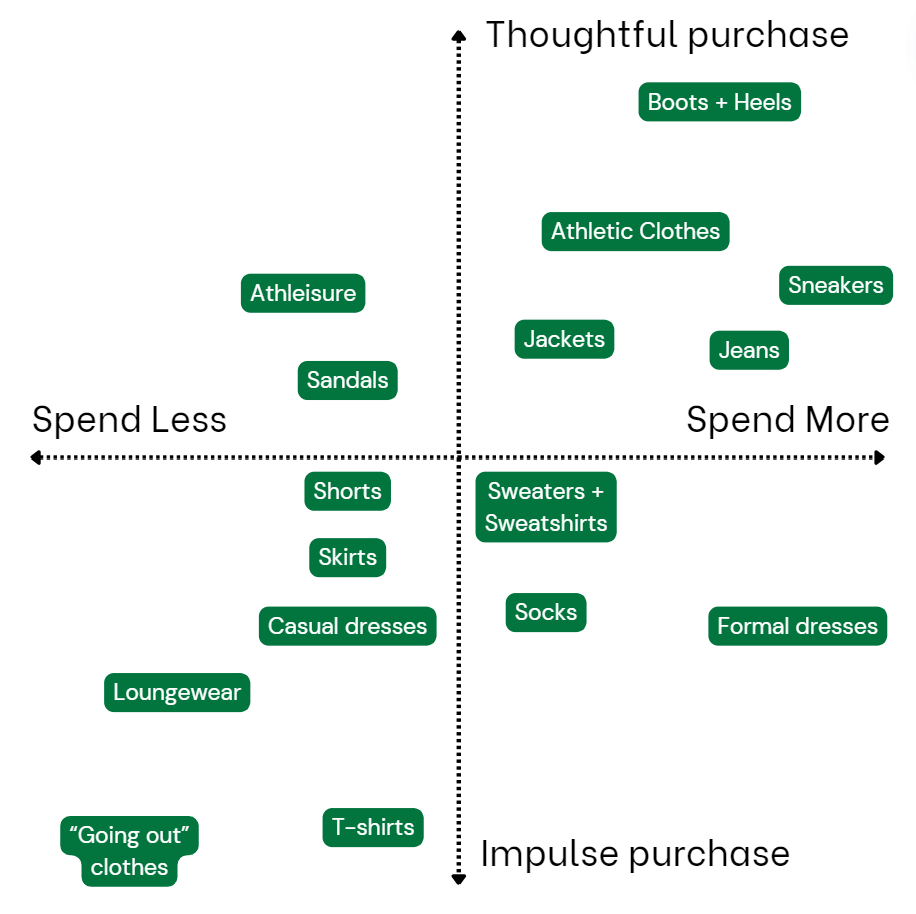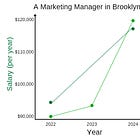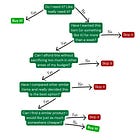Intentional spending in my closet
A chart on intentional spending vs cost of items that you can borrow for your closet
Thanks for checking out Ten Dollar Latte! I’m not a financial advisor, just a 27-year-old trying to afford life in NYC. I write about how I spend my money while enjoying a $10 latte. Subscribe for free!
I spend a lot of money on clothes. In the past few years, I’ve spent thousands on clothes, and this year, it’s at $744.05 so far, trending below previous years due to an intense effort to practice intentional spending. That’s still a lot of money.
I’ve been cleaning out my apartment a bit these past few weeks (summer cleaning? More like a very procrastinated spring cleaning). The bulk of the bags I’ve taken to my local Goodwill have been clothes and shoes. Which got me thinking—how intentional am I really about these items, specifically with regards to how much I’m spending on them? And were they really worth the money, if I ended up getting rid of so much in the end?
And so, like I did to figure out how much to tip, I made a chart:
When making this chart, I considered how much I spend per item and how impulsive the decision is to throw down my credit card.
For the X-axis, I considered the amount I spent per item. I used the cost per item that I spend, and decided if I spent more, less, or the average cost per item (the average pair of socks will cost less than the average jeans, but I normalized to an average). Of course there are extremes—I’ve never shopped at Shein or extremely luxury designer brands.
For the Y-axis, I considered how impulsive these purchases typically are for me. My most impulsive purchases are the ones I make the same day I saw the item, often with no brand loyalty or thought of a budget. My least impulsive purchases are ones I’ve thought through for weeks when I know I trust and love the brand.
I spend a lot of money on shoes (specifically boots, heels, and sneakers), and I consider these one of my more thoughtful purchases purely for comfort—I’m not about to spend money on something that will cause me pain (I’ve done that one too many times years ago and I’m over it!).
I also spend a lot on athletic clothing and have some brand loyalty. This falls under the same reasoning, for comfort. It’s hard to feel comfortable running when it’s raining or 85° outside, but good clothing can help!
I spend more on jackets for their effectiveness. Sure, I do have a couple casual jackets that were less expensive, but my full-length parka that I bought for walking around the city when it’s below freezing was expensive and well thought out.
And for jeans, I spend more and always try these on in store because I want them to fit great. Compared to so many other articles of clothing, it’s so obvious when jeans don’t fit well, and well-fitting jeans can make or break an outfit (and help with confidence!).
I spend less on some more casual shoes that I don’t wear often, like sandals. I still don’t impulse buy shoes though, because I want to make sure they are comfortable enough!
While I spend more on athletic clothes, athleisure is a different story. I bought a lot of athleisure in 2020 and 2021. It’s easier for me to impulse buy these items because if the clothes are a little too big, they’re still comfortable to wear around the house—they don’t have to be the perfect fit.
Shorts, skirts, and casual dresses fell into the impulsive, less expensive category. I don’t think these purchases through as much because these items often are replaceable in my closet by the next “trend”—honestly, this is a mindset I’d like to change and have more staple pieces here.
Even more casual than athleisure, loungewear fell in this category. I have a few items I’ve spent a little more on (Hill House pajamas), but I generally buy less expensive items here.
I was a little embarrassed to write “going out clothes” on this graph (is there an age where this stops being a thing? I think I’ve reached it), but it’s true. These are the items I spend the least amount of money possible on, mainly because I don’t expect to wear them more than a few times and don’t want to be bothered if someone spills a drink on them.
Finally, I put t-shirts here because I have impulse bought a few concert and other event t-shirts in my time. It’s easy to get caught up in the moment and buy an overpriced shirt to commemorate an event.
I’d like to think that anything I purchase that’s expensive I thought out, but that isn’t the case. Sweaters and sweatshirts are casual and I’m not always very intentional with those purchases, but they can be expensive.
I’m also in the habit of adding a few pairs of socks to a Target order—not always the cheapest option, and not the highest quality either. I think it’d be better to spend more here but go with a really intentional brand.
Finally, I left formal dresses in this category. I was a little surprised with myself that this one fell here instead of quadrant 1, but it’s true—I have impulse bought most of the formal dresses I have.
Where does your closet fall in the plot? Any items I’ve missed that you would add? Drop them in the comments!
I post weekly with personal finance & lifestyle tips, plus the Making it in NYC series and my monthly resets. Subscribe so you don’t miss it!
Want to be featured in a future Making it in NYC edition? Submit the form here or send me a DM on Substack.














Loooove the chart ! I have a Notion page with all my clothing spends of the year and I rate each items with a ❤️ or 💔. Since 2020, I’ve been in a journey to reduce my shopping addiction and every year it’s getting better. So far I’ve only spent 500€ (sorry euros here lol) on clothing in 2024, while it was what I could spent easily in a month before haha. Thanks for sharing !
What a great graph! I'm a financial social worker and I use something similar with clients who struggle with spending on clothes or some similar area. It helps to think strategically about what you're happy spending money on and where it makes sense for you to spend money vs where it doesn't - especially when you're not in the heat of the shopping moment. Thanks for sharing!